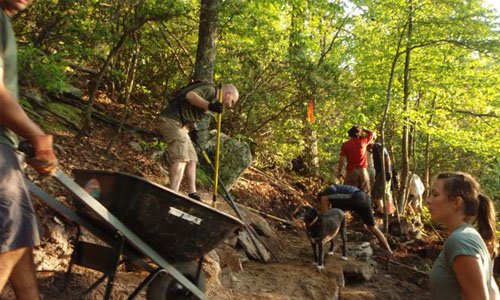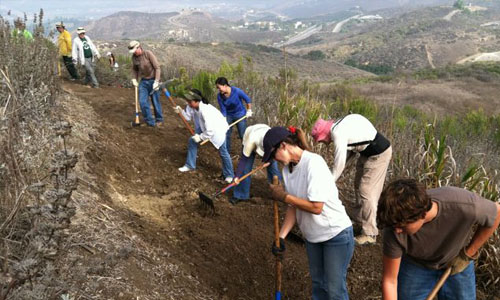Enjoying a Day of Trail Repair Work
Author

Chris shares his passion for cycling, hiking, skiing, and climbing from Buxton, in the Peak District. As a blogger for Outdoor Look, Chris shares outdoor tips and indoor tricks to help you get the most out of your time spent outside. When he's not out adventuring he's making videos or trying to keep up with his 4-year-old son.
 As a hiker, I sometimes feel that volunteering to repair or rebuild an old hiking trail or building a new one is worth the effort, instead of just hiking the existing one. It gives you a new experience of the forest surrounding the trails, and also an opportunity to pay nature back with whatever little you can manage to do.
As a hiker, I sometimes feel that volunteering to repair or rebuild an old hiking trail or building a new one is worth the effort, instead of just hiking the existing one. It gives you a new experience of the forest surrounding the trails, and also an opportunity to pay nature back with whatever little you can manage to do.
But, before going to the trail work, go through the following points to make sure you give your best on the field.
1. Positive Attitude
Your attitude about things is directly related to your performance in the field. Be open to any kind of work or responsibility that might be allotted to you. A positive attitude and an open mind will certainly increase the chances of success, and might also help you mingle with other volunteers. It is a nice way to meet fellow hikers and make new friends.
2. Dress Appropriately
Keep in mind that you are not going on a hike. You are going to lift and pry rocks, harvest soil and build the surface of the trail. Choose leather boots over trail shoes, take your leather work gloves along with a pair of safety glasses. Take all the stuff that you need for hiking and extra water. Labour drains water out of your body more quickly than hiking.
3. Posture Is The Key
The way you carry your tools affects both your performance and the impression you make on other volunteers. Pick up a heavy load while keeping the pressure mainly on your legs, carry your trail building tools by your side, instead of carrying them on your shoulders, with the sharp or pointed ends directed towards the dirt. Try keeping your back straight while carrying heavy loads downhill. This way you reduce the chances of any muscle sprain, and you will considerably improve your performance.
 4. Being Patient Is Important
4. Being Patient Is Important
It isn’t all just picking up some rocks and putting them aside. Trail building is more of a process starting from clearing the floor debris, prying and putting boulders aside, cutting and trimming overhanging tree branches, building erosion zones using smaller rocks and finally settling some soil over the trail. You have to be prepared for a long day of hard work and sweat.
6. Be Open To Learning
With several tasks involved in the trail building process, there is always a chance that you will get to do more than one. Tasks are mainly assigned according to the experience or ability of the volunteer, but you have to be open to the fact that you can be assigned a task you are not really good at. You should be ready to learn about doing such tasks properly. You will also have a better experience if you are enthusiastic and willing to try new things.
7. Hide Your Footsteps
During trail building you have to harvest soil, leaving a pit behind, along with a lot of forest litter, human garbage, and discarded duff. Fill the pits with decomposing leaves, logs and sticks, pack all the human garbage in bags for dumping it in a trash can, and scatter the discarded duff off-trail. Hike trails are inside some natural settings, so while you work, try not to make hazardous changes to the place. Preserving nature should be the top priority.
Author

Chris shares his passion for cycling, hiking, skiing, and climbing from Buxton, in the Peak District. As a blogger for Outdoor Look, Chris shares outdoor tips and indoor tricks to help you get the most out of your time spent outside. When he's not out adventuring he's making videos or trying to keep up with his 4-year-old son.
- Speed Up Your Post-Hike Recovery with These 6 Essential Tips
- Cycling through Tranquil Roads and Coastal Views on the Isle of Wight
- The Essential Guide to Hiking Safety: 5 Tips Every Hiker Should Know
- Run Smart, Run Strong: Your Guide to Injury-Free Running
- Embrace Biking: Essential Tips for Beginners
Categories
- Sport (28)
- Product Reviews (3)
- Team Outdoor Look (7)
- Mike Wild (2)
- Mike Payton (2)
- Suse Hammond-Pears (3)
- Snowboarding (12)
- Latest Offers (105)
- Shop Talk (1)
- Competitions (7)
- Walking (413)
- Lifestyle Fashion (8)
- Travel (86)
- Kit Guides (176)
- Workwear Clothing (6)
- Safety Workwear (4)
- Health/Fitness (289)
- Skiing (91)
- Great Outdoors (1316)
- Cycling (92)
- January 2025
- December 2024
- November 2024
- October 2024
- September 2024
- August 2024
- July 2024
- June 2024
- May 2024
- April 2024
- March 2024
- February 2024
- January 2024
- December 2023
- November 2023
- October 2023
- September 2023
- August 2023
- July 2023
- June 2023
- May 2023
- April 2023
- March 2023
- February 2023
- January 2023
- December 2022
- November 2022
- October 2022
- September 2022
- August 2022
- July 2022
- June 2022
- May 2022
- April 2022
- March 2022
- February 2022
- January 2022
- December 2021
- November 2021
- October 2021
- September 2021
- August 2021
- July 2021
- June 2021
- May 2021
- April 2021
- March 2021
- February 2021
- January 2021
- December 2020
- November 2020
- October 2020
- September 2020
- August 2020
- July 2020
- June 2020
- May 2020
- April 2020
- March 2020
- February 2020
- January 2020
- December 2019
- November 2019
- October 2019
- September 2019
- August 2019
- July 2019
- June 2019
- May 2019
- April 2019
- March 2019
- February 2019
- January 2019
- December 2018
- November 2018
- October 2018
- September 2018
- August 2018
- July 2018
- June 2018
- May 2018
- April 2018
- March 2018
- February 2018
- January 2018
- December 2017
- November 2017
- October 2017
- September 2017
- August 2017
- July 2017
- June 2017
- May 2017
- April 2017
- March 2017
- February 2017
- January 2017
- December 2016
- November 2016
- October 2016
- September 2016
- August 2016
- July 2016
- June 2016
- May 2016
- April 2016
- March 2016
- February 2016
- January 2016
- December 2015
- November 2015
- October 2015
- September 2015
- August 2015
- July 2015
- June 2015
- May 2015
- April 2015
- March 2015
- February 2015
- January 2015
- December 2014
- November 2014
- October 2014
- September 2014
- August 2014
- July 2014
- June 2014
- May 2014
- April 2014
- March 2014
- February 2014
- January 2014
- December 2013
- November 2013
- October 2013
- September 2013
- August 2013
- July 2013
- June 2013
- May 2013
- April 2013
- March 2013
- February 2013
- January 2013
- December 2012
- November 2012
- October 2012
- September 2012
- August 2012
- July 2012
- June 2012
- May 2012
- April 2012
- March 2012
- February 2012
- January 2012
- December 2011
- November 2011
- October 2011
- September 2011
- August 2011
- May 2010
- April 2010
- March 2010
- February 2010
- January 2010
- November 2009
- October 2009
- September 2009
Submit a Comment